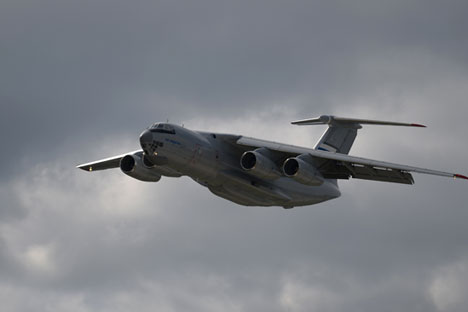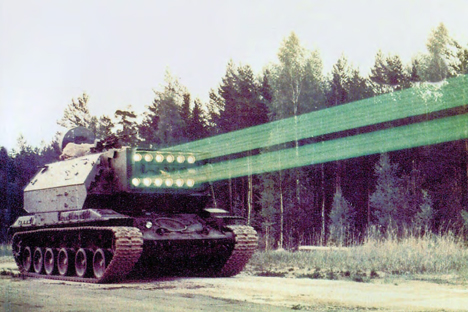Back to the future with laser guns

IL-76MD-90A aircraft at the MAKS-2013 Air Show in Zhukovsky, the Moscow suburbs.
RIA Novosti/Valeriy MelnikovThe latest version of the Il-76MD-90A airplane from the Ulyansk Aviastar factory will be armed with a military laser weapon. The Beriev Aircraft Company on September 14 published information on government orders on their site, saying the testing-design phase had been completed for “ergonomic provision for the development of the A-60SE airplane”.
This indicates that research and development work on laser weapons is going ahead full steam.
The Ministry of Defence in 2012 had announced that Russia had begun work on an aviation based laser gun to be installed on the A-60 aircraft system. The system is designed to destroy enemy airplanes, satellites and ballistic missiles.
At Deputy Prime Minister Dmitry Rogozin’s initiative, the Foundation for Prospective Research was set up that autumn to finance the new project, which used Soviet-era advances in its R&D.
The Soviet Union had actively worked on lasers for new types of weapons. During the Soviet period the codename A60 referred to an aviation-based laser system. It was aimed at developing countermeasures against enemy spy satellites and missiles.
The starting point of the renewed program to develop laser weapons was the A60 special aviation system which was developed in the mid-1970s at the Beriev Aircraft Company. The Il-76MD transport airplane was the base. As part of the work, two flying laboratories were created: the 1A and 1A2.
The А-60 was the peak of the Soviet laser program. The first flight with an onboard laser happened in 1983 and, by 1984, it had hit its first aerial target. The 1A aircraft was lost in a fire at the start of the 1990s. However, the 1A2 flying laboratory, having received specialized equipment in 2005, was named ‘Sokol Eshelon’ (Falcon-Echelon) and began flight tests again. This aircraft hit a hypothetical target in 2009 at a height of 1500 kilometers above the earth.
The renewal and active progress of work to develop a military laser is a logical and timely step, said Alexander Kuzovlev, Associate Professor at the National Research Nuclear University (MIFI) in an interview. Laser weapons have many advantages, like practically unlimited range and high precision fire. It can be concealed and its use can surprise an enemy. Lasers, however, depend on atmospheric conditions. If there are heavy clouds, high humidity or rain, then the laser will be much less effective than in dry conditions. Also, use of a laser weapon requires advanced targeting and locking technologies on the laser itself.
Despite the fact that Russia is intensively carrying out work in this area, it is too soon to talk about an aircraft based laser weapons system that will be accepted into service to destroy missiles and airplanes, said Kuzovlev.
All rights reserved by Rossiyskaya Gazeta.
Subscribe
to our newsletter!
Get the week's best stories straight to your inbox
